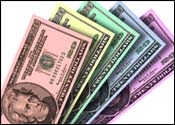NEW YORK (CNN/Money) -
The government plans to unveil the designs of its new $20 bills next month, marking the first time in modern history that a U.S. bill will feature a color other than green.
 |
|
| The Bureau of Engraving hasn't said what color it will choose for the new $20, but think of the possibilities. |
The official unveiling will take place May 13, with the new bill entering circulation in the fall. The Treasury Department's original plan to unveil the bill March 27 was delayed due to the war in Iraq.
The redesigned notes will remain the same size and use similar portraits and historical images, but will include the introduction of subtle background colors. The department has not announced what colors will be used.
The Treasury Department said color itself is not being used as a security feature, but it will enable the addition of features that could prevent counterfeiting.

After the new $20, still featuring Andrew Jackson, goes into circulation this fall, a redesigned $50, featuring Ulysses S. Grant, and a new $100, which carries the image of Benjamin Franklin, are expected to follow in 2004 and 2005.
A new design for $5 and $10 bills still is being considered. The $1 and $2 bills, however, will not be revamped.
The last general redesign of American currency began in 1996, when a new $100 bill was introduced with new features to thwart counterfeiters. A new $50 came in 1997, followed by the $20 in 1998 and new $5 and $10 notes in 2000.
New features on those notes included special ink that appears black from one angle and green from another; a watermark visible only when holding the bill up to the light; and a security strip that runs vertically through the bill. While these features also will be included on the new redesigned bills, they may not fix the problem of counterfeiting.
For more on you and your money, click here
The Secret Service says the percentage of counterfeit bills produced digitally has grown from 1 percent of bogus bills in 1995 -- before the last redesign -- to a whopping 40 percent in 2002.
Dennis Forgue, a rare currency dealer and anti-counterfeiting expert, said in an earlier interview with CNN/Money that many international counterfeiters bleach the surface of small American bills and digitally print the face of a larger bill over them, even though the watermark and security strip remain the same.
"Unless there's some sort of penetrating ink, the new bills won't fix that problem," he said.

| |
|
Don't change the dollar!
|
|
Since last summer, the Bureau of Engraving and Printing has been working with members of the vending machine, gaming and public-transit industries, whose operations could be affected by the new notes.
Brad Quay, vice president of Hamilton Manufacturing, said the department has been providing samples and working with his company, a maker of change machines and other currency handling products, based in Holland, Ohio.
The color in the new bills won't be a problem for the bill-acceptor machines his company makes, he said, but certain aspects of the bills' new appearance will require adjustments.

|

